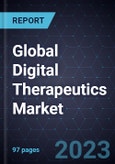Preventive Care and Market Access Strategies Spur New Growth Opportunities
This study presents the overall market and segment-wise revenue forecasts of the global digital therapeutics (DTx) market and highlights key growth opportunities for global DTx market participants.
Patients with long-term chronic conditions increasingly seek safe, evidence-based digital treatments to reduce their medication dosages, reverse triggers of adverse events, and limit healthcare utilization. This is due to the high cost of care associated with these conditions and the need for effective and affordable solutions. Payers and providers seek cost-effective medication alternatives to improve patient engagement, adherence, and convenience while promoting value-based care. The need for disease-reversal and preventive care solutions is also seeing huge demand. Life sciences (LS) companies aim to develop 'around the pill' combination products to enhance patients' treatment experiences. They are also searching for digital biomarkers to assist in drug discovery in the future. LS is partnering with DTx companies to expand their pipelines and develop new treatments for unmet medical needs. In addition, LS is helping DTx companies grow their patient reach globally and achieve their health equity objectives. Collaborations between DTx vendors and medical device companies are also facilitating dosage optimization for personalized therapeutics.
Most digital health technologies have long suffered from being unable to systematically prove their solutions' clinical efficacy via peer-reviewed reports. Thus, they have never secured the unique distinction of being a regulated and "prescription-grade" digital treatment plan that guarantees improved patient outcomes and comprehensive reimbursement at the same time. With the support of rigorous and high-quality decentralized clinical trials, more DTx companies will focus on generating strong clinical, RWE, and HEOR data to prove the safety and effectiveness of their products and drive widespread commercialization.
Additionally, the convergence of biopharma, medical devices, and health technology will play a significant role in shifting toward integrated patient management and holistically supporting the entire patient journey. DTx companies focused on the patient experience must utilize a variety of business models tailored to different customer types, allowing for scalable solutions that enable physicians to recommend their products, patients to use them consistently for a defined period, caregivers to monitor outcomes round the clock, and payers to reimburse the cost of usage.
Collaboration between DTx and LS companies will increase, enabling broader patient reach and increasing scalability alongside risk-sharing agreements. DTx solutions are now considered valid alternatives or adjuncts to traditional pharmacotherapy and are subject to comprehensive regulation. They have been granted prescription status by national or state-level regulatory agencies, such as the FDA, NHS, and CE, based on evidence of improved clinical outcomes for specific patient groups.
The United States is a significant market for growth on a global scale, followed by Europe, where Germany leads the way owing to the highest DTx adoption attractiveness in this region. It is due to higher reimbursement rates and early adoption by payers, providers, and companies in the life sciences and medical device industries.
The disease management application is expected to make up a significant portion of the DTx market revenue worldwide. These solutions enable better patient engagement in chronic care management, lowering healthcare utilization and encouraging self-management of symptoms. This, in turn, incentivizes providers to incorporate these solutions as part of adjunct treatment approaches. Diabetes is expected to have the highest share in revenue within therapy areas and a high CAGR growth rate. This is due to the increasing demand for diabetes management solutions caused by the rising diabetic population worldwide. Additionally, there has been an increase in partnerships between pharma and digital insulin management solutions for connected care. The wellness and behavior management sector will experience revenue growth due to the high demand for mental and cognitive health solutions globally, as well as employers partnering with DTx vendors to provide solutions that enhance employee productivity and wellness. Immersive therapeutics will emerge as an effective treatment approach targeting hard-to-reach and high-risk behavioral health conditions, enhancing patient engagement.
Payers are the primary business users contributing to DTx market revenue. They are expected to reimburse 60% to 66% of the market revenue through different value-based payment plans that patients will be automatically eligible for or subscribed to based on referrals from physicians or formulary decision-makers. Additionally, the role of the providers will become significant as DTx solutions enhance the entire prescriber experience and elevate the current standard of care.








